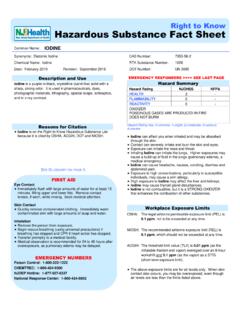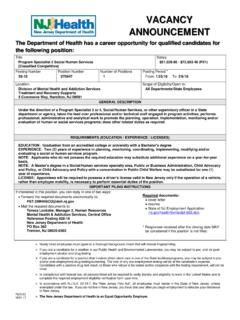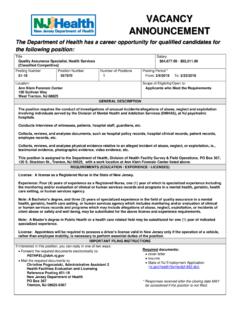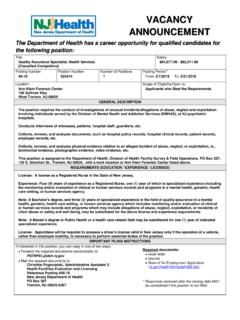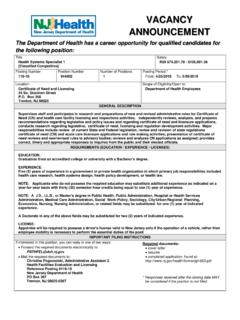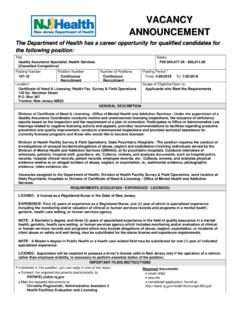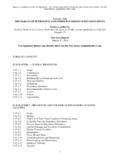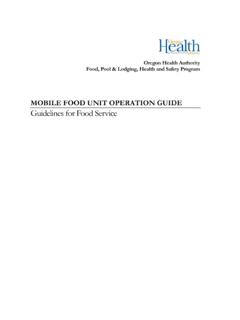Transcription of SODIUM PHOSPHATE DIBASIC - Government of New Jersey
1 Common Name: SODIUM PHOSPHATE DIBASIC CAS Number: 7558-79-4 DOT Number: UN 9147 ---------------------------------------- --------------------------------- HAZARD SUMMARY * SODIUM PHOSPHATE DIBASIC can affect you when breathed in and by passing through your skin. * Contact can irritate the skin and eyes. * Breathing SODIUM PHOSPHATE DIBASIC can irritate the nose and throat causing coughing and wheezing. * High and repeated exposure can cause a skin rash (dermatitis). IDENTIFICATION SODIUM PHOSPHATE DIBASIC is an odorless, colorless, sand-like solid or white powder. It is used to make starch, as an emulsifier in foods, and in the production of enamels, ceramics and detergents.
2 REASON FOR CITATION * SODIUM PHOSPHATE DIBASIC is on the hazardous Substance List because it is cited by DOT and EPA. * Definitions are provided on page 5. HOW TO DETERMINE IF YOU ARE BEING EXPOSED The New Jersey Right to Know Act requires most employers to label chemicals in the workplace and requires public employers to provide their employees with information and training concerning chemical hazards and controls. The federal OSHA Hazard Communication Standard, , requires private employers to provide similar training and information to their employees. * Exposure to hazardous substances should be routinely evaluated. This may include collecting personal and area air samples.
3 You can obtain copies of sampling results from your employer. You have a legal right to this information under OSHA * If you think you are experiencing any work-related health problems, see a doctor trained to recognize occupational diseases. Take this Fact Sheet with you. RTK Substance number: 1723 Date: September 1986 Revision: May 2002 ---------------------------------------- --------------------------------- WORKPLACE EXPOSURE LIMITS No occupational exposure limits have been established for SODIUM PHOSPHATE DIBASIC . This does not mean that this substance is not harmful. Safe work practices should always be followed. * It should be recognized that SODIUM PHOSPHATE DIBASIC can be absorbed through your skin, thereby increasing your exposure.
4 WAYS OF REDUCING EXPOSURE * Where possible, enclose operations and use local exhaust ventilation at the site of chemical release. If local exhaust ventilation or enclosure is not used, respirators should be worn. * Wear protective work clothing. * Wash thoroughly immediately after exposure to SODIUM PHOSPHATE DIBASIC and at the end of the workshift. * Post hazard and warning information in the work area. In addition, as part of an ongoing education and training effort, communicate all information on the health and safety hazards of SODIUM PHOSPHATE DIBASIC to potentially exposed workers. SODIUM PHOSPHATE DIBASIC page 2 of 6 This Fact Sheet is a summary source of information of all potential and most severe health hazards that may result from exposure.
5 Duration of exposure, concentration of the substance and other factors will affect your susceptibility to any of the potential effects described below. ---------------------------------------- ----------------------------------- HEALTH HAZARD INFORMATION Acute Health Effects The following acute (short-term) health effects may occur immediately or shortly after exposure to SODIUM PHOSPHATE DIBASIC : * Contact can irritate the skin and eyes. * Breathing SODIUM PHOSPHATE DIBASIC can irritate the nose and throat causing coughing and wheezing. Chronic Health Effects The following chronic (long-term) health effects can occur at some time after exposure to SODIUM PHOSPHATE DIBASIC and can last for months or years: Cancer Hazard * According to the information presently available to the New Jersey Department of Health and Senior Services, SODIUM PHOSPHATE DIBASIC has not been tested for its ability to cause cancer in animals.
6 Reproductive Hazard * According to the information presently available to the New Jersey Department of Health and Senior Services, SODIUM PHOSPHATE DIBASIC has not been tested for its ability to affect reproduction. Other Long-Term Effects * High and repeated exposure can cause a skin rash (dermatitis). MEDICAL Medical Testing There is no special test for this chemical. However, if illness occurs or overexposure is suspected, medical attention is recommended. Any evaluation should include a careful history of past and present symptoms with an exam. Medical tests that look for damage already done are not a substitute for controlling exposure.
7 Request copies of your medical testing. You have a legal right to this information under OSHA WORKPLACE CONTROLS AND PRACTICES Unless a less toxic chemical can be substituted for a hazardous substance, ENGINEERING CONTROLS are the most effective way of reducing exposure. The best protection is to enclose operations and/or provide local exhaust ventilation at the site of chemical release. Isolating operations can also reduce exposure. Using respirators or protective equipment is less effective than the controls mentioned above, but is sometimes necessary. In evaluating the controls present in your workplace, consider: (1) how hazardous the substance is, (2) how much of the substance is released into the workplace and (3) whether harmful skin or eye contact could occur.
8 Special controls should be in place for highly toxic chemicals or when significant skin, eye, or breathing exposures are possible. In addition, the following control is recommended: * Where possible, automatically transfer SODIUM PHOSPHATE DIBASIC from drums or other storage containers to process containers. Good WORK PRACTICES can help to reduce hazardous exposures. The following work practices are recommended: * Workers whose clothing has been contaminated by SODIUM PHOSPHATE DIBASIC should change into clean clothing promptly. * Do not take contaminated work clothes home. Family members could be exposed. * Contaminated work clothes should be laundered by individuals who have been informed of the hazards of exposure to SODIUM PHOSPHATE DIBASIC .
9 * Eye wash fountains should be provided in the immediate work area for emergency use. * If there is the possibility of skin exposure, emergency shower facilities should be provided. * On skin contact with SODIUM PHOSPHATE DIBASIC , immediately wash or shower to remove the chemical. At the end of the workshift, wash any areas of the body that may have contacted SODIUM PHOSPHATE DIBASIC , whether or not known skin contact has occurred. * Do not eat, smoke, or drink where SODIUM PHOSPHATE DIBASIC is handled, processed, or stored, since the chemical can be swallowed. Wash hands carefully before eating, drinking, applying cosmetics, smoking, or using the toilet.
10 * Use a vacuum or a wet method to reduce dust during clean-up. DO NOT DRY SWEEP. PERSONAL PROTECTIVE EQUIPMENT WORKPLACE CONTROLS ARE BETTER THAN PERSONAL PROTECTIVE EQUIPMENT. However, for some jobs (such as outside work, confined space entry, jobs done only once in a while, or jobs done while workplace controls are being installed), personal protective equipment may be appropriate. SODIUM PHOSPHATE DIBASIC page 3 of 6 OSHA requires employers to determine the appropriate personal protective equipment for each hazard and to train employees on how and when to use protective equipment. The following recommendations are only guidelines and may not apply to every situation.


